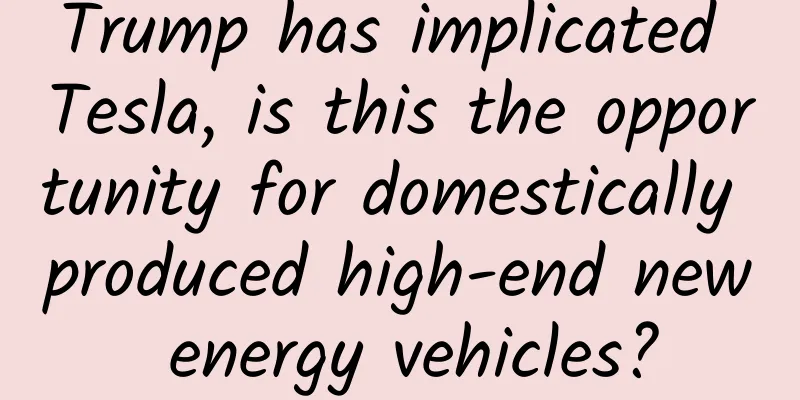Trump has implicated Tesla, is this the opportunity for domestically produced high-end new energy vehicles?

|
On June 16, because Trump insisted on provoking a trade war, China decisively announced its response measures, stating that it would impose a 25% tariff on 659 items of imported goods originating from the United States, totaling about US$50 billion, on July 6. American-made cars were also among the items subject to the tariff increase. Yesterday, American investment company JL Warren said that Tesla has stopped accepting custom orders from China and only sells onshore vehicles. It is believed that if a 25% tariff is really imposed, Tesla will face extremely high sales difficulties in China. For example, the price of the MODEL X 75D will increase by 150,000 yuan after the new tax rate adjustment. In addition, as Trump insists on his own way, Tesla's plan to build a factory in China will basically be shelved indefinitely. If the problems of factory construction and tariffs cannot be resolved, Tesla is likely to miss out on China, the largest new energy vehicle market. It’s not easy to replace it with domestic brands! If Tesla Model 3 is mass-produced in China, not only will the import tax be saved, but the production cost will also be reduced, and its selling price is likely to break through the critical point of RMB 200,000. In addition, if Tesla can enjoy subsidies, it will win the favor of more consumers. Considering Tesla's strong brand appeal, this will have a very big impact on domestic new energy vehicle companies. But now with the increase in tariffs, Tesla's prices have also risen, and building a factory seems out of reach. For domestic car companies, this is tantamount to winning a period of precious preparation time. However, this does not mean that domestic new energy vehicles will definitely have the opportunity to get a share of the pie in the mid-to-high-end field. Although China is already the world's largest auto market, most domestically produced cars, whether traditional fuel vehicles or new energy vehicles, are still low-end. However, impacting the mid-to-high-end field is both a need for industrial upgrading and represents the dream of the Chinese auto industry. The Chinese auto industry has made many attempts to enter the mid- to high-end market, but all attempts have failed. In fact, the independent research and development and technology accumulation time of China's independent brands is still very short, only about twenty years. The time is not yet ripe for China to compete with first-tier car companies with its current technological accumulation. The automotive industry has a high technical threshold and requires long-term accumulation to achieve substantial progress. Domestic cars have long been synonymous with cost-effectiveness. Strictly speaking, this is not about building a mid-to-high-end brand, but a price war of low prices and high configurations. The significance of a brand is to be able to sell a lower configuration at a higher price, that is, to obtain a brand premium. Low-price, high-configuration products are not only easy to be imitated and surpassed, and cannot form core competitiveness, but also lead to narrow profit margins, restrict further research and development upgrades, and form a vicious cycle. If domestic brands want to enter the mid- to high-end market, excellent technology and product quality are the most basic conditions. Pursuing brand without considering quality is just wishful thinking. From this perspective, some domestic brands already have the basic conditions. For example, Geely, in addition to independent research and development, has also introduced advanced technologies through overseas acquisitions, and after digestion and absorption, it has acquired impressive strength. Impacting mid- to high-end brands means that domestic auto brands are beginning to challenge dominant brands. In addition to product quality, accumulating a massive user base is also a necessary foundation. If the original brand does not have a sufficient market foundation, it is a very risky behavior to upgrade rashly. Only by maintaining the original user base and market reputation and tapping the potential of users of its own mid- and low-end cars can it further compete for users of other brands. In addition to bottom-up upgrades, top-down promotion is also a path. Tesla first developed supercars, then high-end cars, and then launched popular models. Domestic Internet cars such as Weilai are imitating this path. China is the world's largest auto market. The huge market gives Chinese auto brands a clear home advantage in the process of impacting the mid-to-high-end market. The ongoing new energy vehicle revolution has given domestic auto brands an opportunity to overtake others. I believe that competitive mid-to-high-end brands will emerge in the Chinese auto industry sooner or later. Who will be the biggest winner? In February this year, BMW announced that it had signed a "Letter of Intent for Cooperation" with Great Wall Motors to establish a joint venture to produce MINI pure electric models in China. On May 29, BMW started construction of the second phase of the battery factory dedicated to the domestic electric SUV iX3. On June 5, Audi China General Manager Wei Yongxin announced that Audi will produce pure battery electric vehicles in China in 2020 or 2021. Audi said that it will launch 10 pure electric vehicle models in China in 2022, covering all levels of market segments. According to the schedule released by BBA, new energy vehicles from the three major luxury car manufacturers will all be produced in China around 2020. Although the current business focus of BBA is still on traditional fuel vehicles, it has long been preparing for the research and development of new energy vehicle technology, and the technology has become increasingly mature. In China's new energy vehicle market, the reason why BBA is relatively silent and Tesla has become the industry benchmark is more because at the beginning of the market, BBA adopted a market strategy of using static to dynamic, leaving the heavy market education to Tesla and waiting for opportunities to act. Once the market matures, BBA is confident that it will continue to have advantages even in the field of new energy vehicles, relying on its rich experience in automobile production, deep market foundation and strong brand penetration. Now that Tesla is facing obstacles in terms of tariffs and factory construction, this is undoubtedly good news for BBA, which is making efforts to enter the Chinese new energy vehicle market. For China's emerging new energy vehicle brands, challenges will continue to exist. As a winner of Toutiao's Qingyun Plan and Baijiahao's Bai+ Plan, the 2019 Baidu Digital Author of the Year, the Baijiahao's Most Popular Author in the Technology Field, the 2019 Sogou Technology and Culture Author, and the 2021 Baijiahao Quarterly Influential Creator, he has won many awards, including the 2013 Sohu Best Industry Media Person, the 2015 China New Media Entrepreneurship Competition Beijing Third Place, the 2015 Guangmang Experience Award, the 2015 China New Media Entrepreneurship Competition Finals Third Place, and the 2018 Baidu Dynamic Annual Powerful Celebrity. |
<<: DJI dominates the consumer drone market, but what about the professional field?
>>: Mercedes-Benz EQC will be released in September, further information revealed
Recommend
Seven Tips to Increase App Revenue (Part 1)
Mobile marketing is a fluid ecosystem. If CPs wan...
Google AdWords detailed tutorial from account registration to advertising
If you want to advertise on your own cross-border...
KOL is too expensive, do you know more about KOC marketing?
There is not enough budget to continue looking fo...
Wandering "Love Rival Strategy Video Course" + "Love Rival Handbook"
Introduction to the resources of Langji's &qu...
The Great Emperor of Heaven and Earth: Emperor Wu of Han
" Amazing King of Heaven and Earth: Emperor W...
Struggling! After dating for a year and a half, I found out that my boyfriend has a family history of cancer. Is it hereditary? Should I break up?
Some time ago, I was bored and browsing posts in ...
Outlook for 2016: The electronics industry continues to embrace the Internet of Things
Time flies, and a new year has arrived. The elect...
What are the biggest risks facing companies in the face of the rapid development of artificial intelligence?
AI has the potential to bring “significant benefi...
After the stock price soared, is Thunder Wanke Coin really a scam?
Recently, something extraordinary seems to have h...
Electric Technology Car News: Buying the top-spec Haima S7 for 140,000 yuan vs. Haval H6, which domestic SUV should I choose?
Speaking of Haima Automobile, many people probabl...
Detailed explanation on how to quickly reconstruct the operation strategy of private domain e-commerce
Tencent’s official definition of private domain i...
Why do we sneeze when we see bright light? | Science Museum
Have you ever seen this phenomenon: you are fine ...
Is Xiaohongshu’s advertising traffic restricted? Xiaohongshu’s flow limit guide!
Preface Whenever Double Eleven is approaching, ma...
An excellent Android application starts with building a project
[[146519]] 1. Project Structure The MVP model is ...









